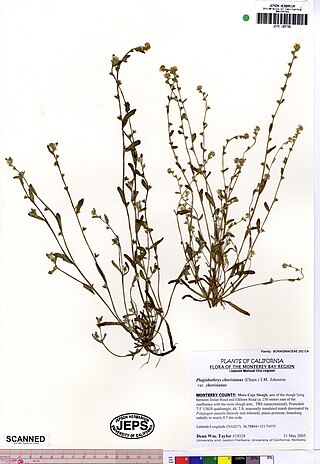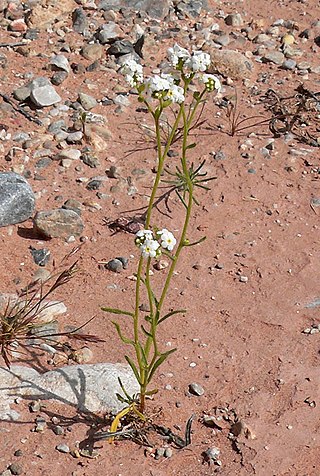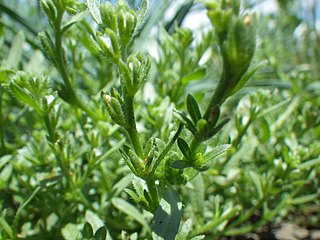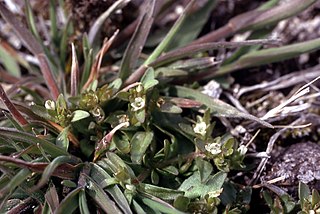
Hooveria purpurea is a species of flowering plant related to the agaves known by the common name purple amole. This species of soap plant is endemic to California, where it grows in the Santa Lucia Range, in the Central Coast region. There are two varieties of this plant, and both are believed to be quite rare. It is a federally listed threatened species.

Plagiobothrys acanthocarpus is a species of flowering plant in the borage family known by the common name adobe popcornflower. It is native to California and northwestern sections of Mexico, where it can be found in moist areas on clay soil, such as vernal pools. It is an annual herb with a spreading or erect stem 10 to 40 centimeters in length. The leaves are linear or lance-shaped to oblong and several centimeters in length. The plant is coated in rough hairs. The inflorescence is a series of tiny flowers, each with a yellow-throated, five-lobed white corolla less than 3 millimeters wide. The nutlets are covered in long prickles with some bristles between.
Plagiobothrys austiniae is a species of flowering plant in the borage family known by the common name Austin's popcornflower. It is native to California, where it can be found in the Central Valley and Sierra Nevada foothills. It is also known from southern Oregon.

Plagiobothrys chorisianus is a species of flowering plant in the borage family known by the common name artist's popcornflower. It is endemic to California, where it can be found in and around the San Francisco Bay Area and parts of the coastline to the south.
Plagiobothrys distantiflorus is a species of flowering plant in the borage family known by the common name California popcornflower. It is endemic to California, where it is known only from the northern and central Sierra Nevada foothills.

Plagiobothrys fulvus is a species of flowering plant in the borage family known by the common names field popcornflower or fulvous popcornflower. It is native to California and Oregon in the United States, as well as Chile.
Plagiobothrys glyptocarpus is a species of flowering plant in the borage family known by the common name sculptured popcornflower. It is native to Oregon and northern California, where it grows in moist woodland and grassland habitat. It is an annual herb growing mostly erect to a maximum height near half a meter. The leaves along the stem are 4 to 8 centimeters long and the herbage is coated in rough hairs. The inflorescence is a series of small white flowers with rounded five-lobed corollas 2 to 9 millimeters wide. The fruit is a nutlet about 2 millimeters wide with a rough, tubercled or ribbed surface visible on magnification.
Plagiobothrys greenei is a species of flowering plant in the borage family known by the common name Greene's popcornflower.
Plagiobothrys humistratus is a species of flowering plant in the borage family known by the common names dwarf popcornflower or low popcornflower. It is endemic to the Central Valley of California, where it grows in grassland habitats, including vernal pools and other wetland areas.

Simpsonanthus jonesii is a species of flowering plant in the borage family known by the common name Mojave popcornflower. It is the sole species in genus Simpsonanthus. It is native to the southwestern United States and northern Mexico, where it grows in desert mountains and flats in scrub and woodland habitat.

Plagiobothrys leptocladus is a species of flowering plant in the borage family known by the common names finebranched popcornflower and alkali plagiobothrys. It is native to western North America from Alaska to the Dakotas to northern Mexico, where it can be found in varied types of wet habitat, including inundated alkali flats and vernal pools.
Plagiobothrys mollis is a species of flowering plant in the borage family known by the common name soft popcornflower. It is native to Oregon, Nevada, and the Sierra Nevada of California, where it grows in scrub and grassy habitat, especially in moist and wet areas.
Plagiobothrys parishii, known by the common name Parish's popcornflower, is an uncommon species of flowering plant in the borage family.

Plagiobothrys scouleri is a common species of flowering plant in the borage family known by the common name Scouler's popcornflower and white forget-me-not. It is native to North America, where it can be found from Alaska throughout southern Canada and the western and central United States. It is present in the United Kingdom as an occasional introduced species.
Plagiobothrys shastensis is an uncommon species of flowering plant in the borage family known by the common name Shasta popcornflower. It is native to southern Oregon and northern California, where it grows in grassland, woodland, and other types of habitat. It is an annual herb growing erect to about 30 centimeters in maximum height. It is coated in hairs. The leaves are located in a basal rosette with a few arranged alternately along the stem. The inflorescence is a straight branch holding paired flowers, rarely coiling at the tip as many other Plagiobothrys do. Each tiny white flower has a five-lobed corolla no more than 3 millimeters wide. The fruit is a cross-shaped nutlet 2 or 3 millimeters wide divided in half by a rough scar.

Plagiobothrys stipitatus is a species of flowering plant in the borage family known by the common name stalked popcornflower and stipitate forget-me-not. It is native to Oregon and most of California, where it grows in vernal pools and similar wet habitat types. It is an annual herb producing a narrow, hollow, erect stem up to half a meter tall. It is coated in rough hairs. The pointed, hairy leaves along the stem are up to 11 centimeters long. The inflorescence is a series of five-lobed white flowers 2 millimeters to over one centimeter wide. The fruit is a narrow, ribbed nutlet.
Plagiobothrys strictus is a rare species of flowering plant in the borage family known by the common name Calistoga popcornflower. It is endemic to Napa County, California, where it is known from only two small locations near Calistoga.
Plagiobothrys tenellus is a species of flowering plant in the borage family known by the common names Pacific popcornflower and slender popcornflower. It is native to western North America from British Columbia to Mexico, where it is a common member of the flora in several types of habitat.
Plagiobothrys uncinatus is a species of flowering plant in the borage family known by the common names Salinas Valley popcornflower and hooked popcornflower. It is endemic to the Central Coast Ranges of California, where it is known mainly from the Santa Lucia Mountains and Gabilan Range in Monterey County.
Amsinkiopsis is a monotypic genus of flowering plants in the borage family consisting of the species Amsinckiopsis kingii. A. kingii was previously considered part of the genus Plagiobothrys, until phylogenetic study proved the genus to be polyphyletic.








